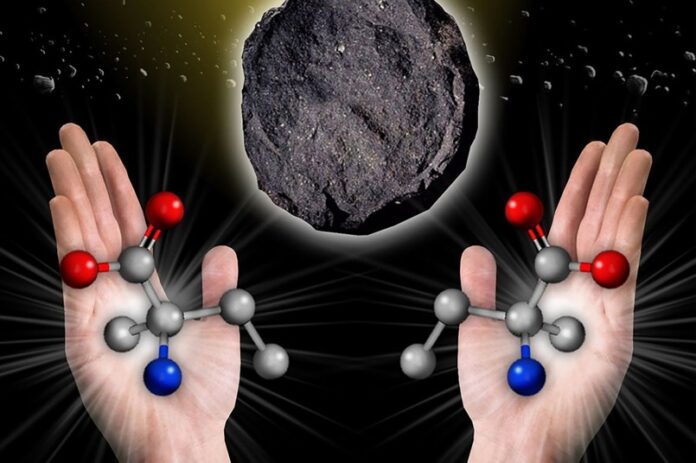Do you know what chirality is? Your hands are chiral objects, that is, if superimposed on each other they do not match up. They are mirror images.
Try this to see what I am talking about. With both hands face up, place one on top of the other. The result is the two do not align. The thumb on one overlaps the pinky finger on the other. They cannot superimpose upon each other like achiral objects, for example, two identical bottles.
So what does chirality or achirality have to do with the origins of life? A paper published in Nature Communications on September 12, 2024, authored by scientists from NASA’s Goddard Space Flight Center and the University of California-Los Angeles (UCLA) describes how life on Earth could have taken a completely different turn based on molecular chirality. In other words, the way life came into existence and the nature of what life on Earth turned out to be may have resulted from a chemical coin toss.
In chemistry, molecules are often mirror images just like the hands in the above example. You can see chirality in DNA, RNA and amino acids, the latter the building blocks of proteins. All life on Earth has left-handed amino acids and right-handed sugars. Mirror images would produce right-handed amino acids and left-handed sugars called enantiomers.
Enantiomers could have existed when life first began to emerge on Earth. Today, however, enantiomers don’t exist here, but they very well may be found elsewhere in the Universe producing a very different life.
Life is distinctly one-handed or homochiral. It has been almost right from the beginning. Alberto Vázquez-Salazar, a UCLA Samueli postdoctoral scholar believes that this homochirality might not have come about as a result of chemical determinism but through the toss of a coin. He states in a UCLA presser:
“The findings suggest that life’s eventual homochirality might not be a result of chemical determinism but could have emerged through later evolutionary pressures.”
The development of RNA molecules at the beginning may have exhibited greater flexibility and adaptability. The molecules could have demonstrated both left and right-handed properties. The NASA and UCLA researchers tried to simulate the period of time some billion years ago in what they call the pre-life RNA world.
The Nature Communications paper states that the “RNA World hypothesis posits that at some point on the early Earth, life went through a stage in which RNA played both roles of information carrier and catalyst in primitive living systems.” A critical bridge would have included self-assembling molecules with Earth conditions allowing for the incubation of sugars and amino acid precursors that neither favoured right versus left-handedness. In that early RNA world, the Earth may not have been predisposed to one or the other-handedness.
The lack of a preference could have produced very different outcomes demonstrating the flexibility and adaptability of RNA and leading to multiple living iterations exhibiting different characteristics. Instead, however, life emerged here on Earth dominated by left-handed amino acids that today make up the proteins in our cells.
Left-handed amino acids or L-types are organic molecules with a central carbon atom bonded to four different groups: an amino, carboxyl, hydrogen and side chain that have two mirror-image forms similar to our left and right hands. We refer to right-handed amino acids as D-types. It is L-type amino acid chains that make the proteins found in our cells. They work with right-handed sugars to make the proteins found in the biological molecules that are precursors to life here on Earth.
This may not be the case elsewhere. In 1969, a meteorite exploded above Murchison, Australia with its fragments scattered over 35 square kilometres (13.5 square miles). Around 100 kilograms (220 pounds) of meteorite fragments were recovered with the last weighing nearly 7 kilograms (nearly 15 pounds). That fragment can be seen in the image at the top of this article. The presence of isovaline, an amino acid found in the fragments, appeared both in left-handed and right-handed versions. Was Murchison unique or the norm for chemical evolution in the Universe? We don’t know.
That’s why NASA has been studying the samples extracted from Bennu brought back in the OSIRIS-REx mission, and JAXA has been studying samples from Ryugu brought back in 2020 to see if amino acids from these two asteroids exhibit homochirality or not. That’s also why NASA and ESA will study chirality should a future mission bring back the 43 potential samples Perseverance is in the process of collecting. Then we may have enough of an extraterrestrial sample size to compare with Earth’s particular homochirality.
Unfortunately, we cannot return to pre-life Earth because plate tectonics has wiped out the physical evidence over 4 billion years. But Murchison, Bennu, Ryugu and Mars may produce confirmation that chemical determinism has nothing to do with how life evolves but rather results from an evolutionary throw of the dice. In the future, we may meet extraterrestrials built from D-type amino acids. It certainly makes for interesting speculations.










[…] in November 2024, I wrote a posting about chirality with an explanation of why life on Earth is comprised of left-handed (L-amino) acids and […]
[…] metamaterials introduce the term chirality into the negative refraction explanation. Molecular chirality has been described as a significant […]